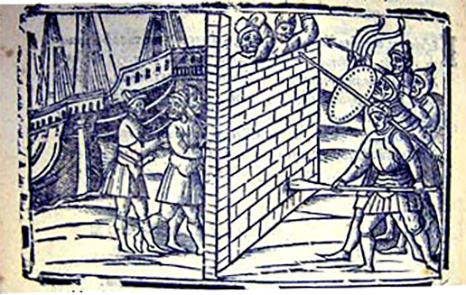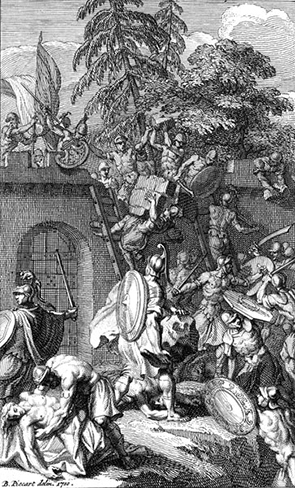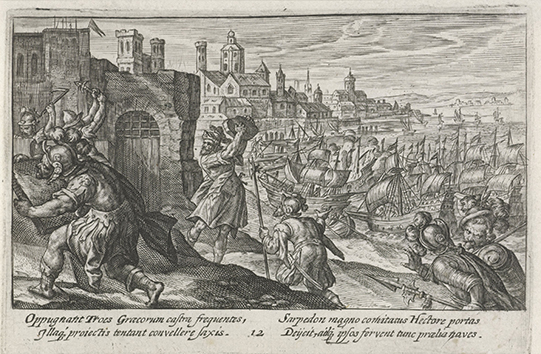

This book is an account of how the Trojan forces, led by Hector, attack the Greek rampart and breach its walls.
The book begins with an account of the rampart the Greek forces have built to protect their last line of defence, their ships. The rampart is a high wall with a trench beneath it. But Homer breaks the action of the story here to tell his audience the fate of the rampart. He tells his audience that the rampart did not last long after the war because the necessary sacrifices to the gods were not made, and so in the years after the war the gods set about destroying it by natural means: with the power of the sea and by diverting rivers against it.
As the action begins the Greek forces are “pinned to their beaked ships in dread of Hector” (line 47). The battle rages on. Hector spurs his men to cross the trench. But Hector realises his horses cannot cross the trench. Then Polydamas speaks, also pointing out the problem the defensive wall causes them. The stakes in the trench are a hazard, there is little room to fight, and if they cross the trench and are pushed back they might be trapped. Hector sees the sense of his words and orders his forces to abandon their chariots. He has his army form five battalions, led by captains like Paris and Sarpedon. Under this new arrangement the Trojans attack. Asius, a captain, refuses to abandon his horses and chariot and uses them to attack the gate guarded by Polypoetes and Leonteus, two Lapith commanders. He is cut down with a spear – “his accursed doom blacked him out / with Idomeneus’ spear (lines138-139) – although about fifty lines later Homer has him express a feeling of despair as he witnesses the resolute defence mounted by the Greeks.
Polypoetes and Leonteus defend the gate fiercely. They throw rocks down upon the heads of the Trojans. They spear and kill fighters like Damasus, Pylon and Ormenus. At this point, the Trojans lose some confidence. An eagle flying to the left of them is bitten by a snake it is carrying off, and the bird drops the snake among their ranks. Polydamus believes the omen foretells large losses if they attack across the trench. Based on this bad omen he advises Hector to call off the attack. But Hector refuses to credit Polydamus’ interpretation. He believes Zeus has promised him a victory and he intends to trust Zeus. Hector turns on Polydamus, accusing him or cowardice, and demands he fight or risk being executed. Hector then leads the charge and Zeus sends a dust cloud against the Achaeans. Once again the Trojans try to breach the Greek rampart and the Greeks throw rocks down at them. The Aeantes brothers, Ajax and Teucer, urge their comrades to stand fast against the onslaught. The Greek forces throw so many rocks against the Trojans that Homer describes it resembling falling snow.
Zeus’ son, Sarpedon, with his mighty shield, charges the wall. It is a heroic act. Sarpedon says to Glaucus, his second in command, that actions like this are what justify the glory they receive and the life of privilege and ease they live at home. He urges Glaucus and his men on and that he would rather not be fighting. On the Greek side, Peteos, seeing the danger of the attack, urges a herald to deliver a message to Ajax, asking for his and his brother’s help. Ajax agrees to help. Ajax and Teucer make their way to Peteos’ rampart. Ajax immediately kills Epicles with a massive rock, too heavy for a normal man to lift. Teucer kills Glaucus with an arrow. Sarpedon sees Glaucus’ death. He redoubles his own efforts and manages to tear wood from the rampart with his hands, creating a large hole. Ajax and Teucer focus their attacks on Sarpedon. But Zeus helps deflect Teucer’s arrow and Sarpedon’s shield deflects Ajax’s spear. Sarpedon turns to his men, calling for help to breach the wall, saying he cannot do it alone.
Sarpedon’s men back him and there is a fierce battle at the breach in the rampart. Hector calls for fire to be set to the ships.
As the battle rages on, Zeus intervenes again. He gives Hector temporary inhuman strength so that he, like Ajax before, is able to lift a massive boulder. He uses the boulder like a battering ram to attack the gate of the rampart. The gate is smashed open. Hector calls for his men to storm the wall, and this book ends as the Trojan forces pour through the opening and the Argive forces fall back in terror.
One of the most interesting aspects of this Book of The Iliad is the Achaean wall – the rampart – which the Trojans attack and breach.
The wall is first suggested by Nestor in Book 7. After both sides call a halt to the fighting for a chance to bury their dead, Nestor suggests:
In Book 12 the rampart is further described:
Homer has chosen to begin Book 12 by breaking the action and describing the fate of the Achaean Wall, treating it much like a character in his story, deserving of our attention. The wall appears ill-fated since the Achaeans,
In Book 7 Poseidon complains to Zeus that the Achaeans are building the wall without sacrificing to the gods. He demands the wall be destroyed, but Zeus, angry with Poseidon, tells him,
Which is exactly what happens at the beginning of Book 12. Homer tells his audience that the wall stood while ever the Trojans remained undefeated. But after their defeat, “. . . Poseidon and Lord Apollo launched their plan / to smash the rampart, flinging into it all the rivers’ fury.” (Book 10, lines 20 – 21) They divert the course of rivers against the rampart, send storms against it and use the breaking surf against it to wash all evidence of it away.
It is a petty effort by these gods which describes the effects of the natural elements against the rampart. But it is interesting to speculate why Homer thought it important to begin the twelfth book of The Iliad with what to modern readers would feel like an aside. There is a lot of speculation about it in scholarly journals, but I thought I would suggest a few thoughts from my reading of the book.
It is probable that Homer’s contemporary audience would know the location of Troy. And while the walls of Troy remain to this day, a wooden fortification on the shore of Troy would not likely have lasted long. So that is a first suggestion: Homer understands that his story does not match the physical remains of Troy but intends that his story be understood as a real history. The ancients believed the siege of Troy happened as Homer described it. His story about the pettiness of the gods explains how completely the remains of the fortification is gone.
Another thought is that this opening is closing a narrative arc that Homer has not developed. It is a fulfilment of the promise Zeus makes to Poseidon in Book 7. Homer’s return to the subject shows that he considers the realm of Olympus as important as the action in the mortal world: that the gods are a literal explanation of the world.
Other academic sources read the wall as a symbol of one kind or another. For instance, the wall, itself, though inanimate, has been imbued with a fate from the moment of its construction. The wall’s destruction is a reminder of fate, and since the story of Troy was so well known in ancient times, it would have had a fatalistic air to it. Characters like Achilles are burdened with prophecies: he will either die young in glory, or live to be old and forgotten. The wall is a reminder that nothing escapes its fate.
To this end, Homer may have made the wall up. It is a useful device in the middle of the poem to show the turn of fortunes against the Greeks and to anticipate their later triumph, although Homer declines to show it. But having all evidence of the wall obliterated also suits his purpose.
There is also the matter of the wall’s association with the burying of the Greek dead. The Greeks dig a large pit to place their dead in and then heap earth over it to create a barrow, before building the wall in front of the barrow and then a defensive pit on the other side to face the Trojans. Presumably, from this description, taken from lines 386 – 395 of Book 7 (see above), the barrow then forms the walkaway behind the rampart from which the soldiers can mount their defence. The destruction of the rampart by Poseidon and Apollo includes the destruction of the barrow. While the barrow and rampart are memorialised by Homer, their destruction also symbolises the transitory nature of our own legacies.
One last thought lies with the ending of The Iliad. Despite what many think, the destruction of Troy does not occur in The Iliad. The Iliad ends with the death of Hector and his funeral. Some of the most famous elements of the story – the Trojan Horse and the sacking of Troy – actually occur in Vergil’s The Aeneid. As such, the breaching of the Achaean Wall is the only moment of a successful siege related in The Iliad. Homer’s audience would have known the eventual outcome of the story, so this would seem to foreshadow Troy’s end which exists beyond the ending, making the Trojan’s success at this point an ironic victory. Again, the destruction of the wall speaks to the matter of fate.

Nikolaos Loukanis’ version of The Iliad, first published in Venice in 1526 was the first translation of the work into Modern Greek. It featured 121 woodcut prints.
This woodcut is a wonderful rendition of the scene in which the Trojans attack the rampart, even though it does not attempt to give an accurate representation of the scene.
It owes more, stylistically, to medieval art, given the strange proportions of the wall, the ships and fighters. The whole scene has a stage-like quality, and despite the action, is quite static. The battle dress of the fighters appears to be more contemporary than historical. The wall is made either of brick or stone, while Homer describes it as a wooden structure. Sarpedon is able to tear planks of wood from the wall to create a hole. And if we interpreted the image literally, we see that the wall is short and could be walked around. Clearly, this is not a literal interpretation.

This engraving comes from the workshop of Bernard Picard. The original print has a French caption at the bottom which, when translated, reads:
The figure in the middle of the composition with a shield on his back is presumably Hector with a stone in his hand, just before he attacks the gate. The action about him resembles some of Homer’s descriptions: masonry is tossed from the wall to kill attackers. According to Ancient Warfare Magazine there is some evidence that siege ladders were used in ancient warfare:

The depiction of siege ladders in this Phoenician bowl gives some credence to the use of ladders in the Picard representation of the Trojan attack. However, siege weapons like battering rams were not used during this period. This is why Hector employs a heavy boulder to break down the gate of the Achaean rampart. The wooden rampart, as described by Homer, has been represented in this image as a stone fortification more akin to a medieval castle in this image.

This engraving by Crispijn van de Passe has a Latin caption which describes how the Trojans attacked the Greek camp, and how Sarpedon and his company threw down the gates with Hector, thereby taking the battle all the way to the Greek ships. This is a paraphrase since some of the lettering in the inscription is difficult to read accurately.
The image is also somewhat ambiguous, with many obvious mistakes. First is the rampart wall, itself. This appears to be represented by the structures to the left of the figures. Homer describes the rampart as a wooden feature which was quickly constructed. The image makes it appear as substantial as a town. Either that, or the buildings are Troy, itself, which means Troy is too close to the water, leaving no fields upon which the battles can take place, and no rampart wall between the ships and Trojans.
Two figures are either raising or carrying large rocks in this image. In the poem, Ajax kills Epicles with a massive stone. Hector is also given the strength by Zeus to break the rampart gates with a boulder. And then there are the many defenders who toss stones and masonry on the heads of the Trojan attackers. But the figure raising the stone above his head is not on the battlement to throw it upon his enemies’ heads as a defender. Instead, his proximity to a door or gate suggests he might be Hector, ready to break it open. This, too, is problematic, since if this is Hector he is already within the Greek encampment. The figures in the image all look more like attackers than defenders. Yet the Latin caption clearly makes this image about the breaching of the rampart in Book 12.
Another strange detail is the depiction of the Greek fleet. Forget that the ships are historically inaccurate. They appear to be in full sail, anchored at the shore.
Comments
No one has commented yet. Be the first!